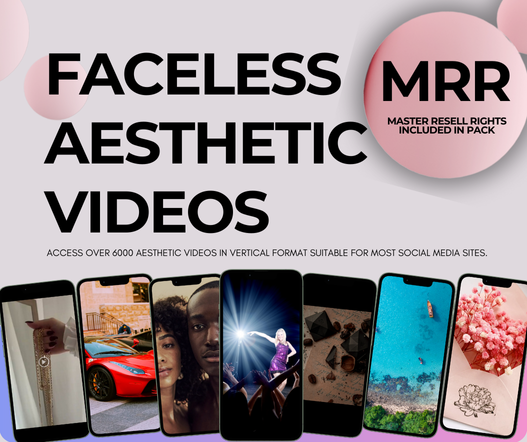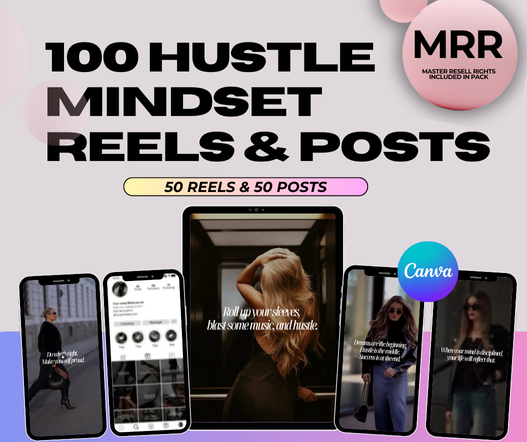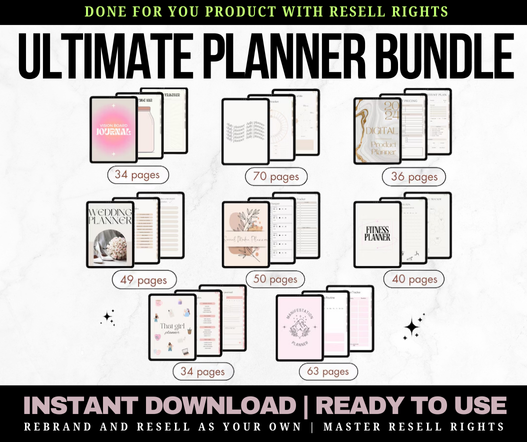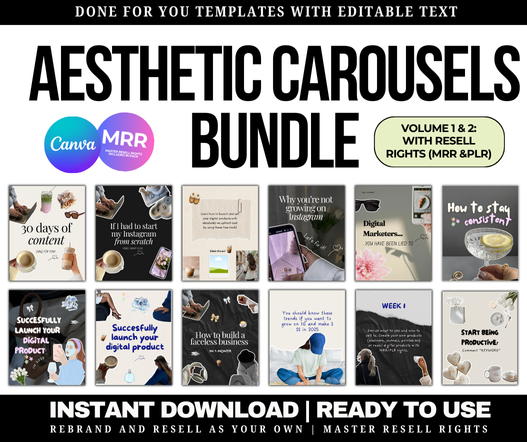How to Sell Digital Products in 2026: Complete Beginner's Guide + First Sale in 48 Hours
Share
How to Sell Digital Products: The First Sale Formula (2026 Guide)
You've probably seen the Instagram posts. Someone in their twenties just made $10,000 selling digital planners. A stay-at-home parent is earning passive income with templates. Your college roommate just quit their job to sell digital products full-time.
And you're thinking: "How do they actually do this?"
Here's the truth. Learning how to sell digital products isn't hard. But most beginners get stuck in the same place—they buy PLR products, watch tutorials, and then... nothing happens.
This guide shows you exactly how to sell digital products and make your first sale in 2026. No fluff. No complicated tech stuff. Just the real steps that actually work.
What Are Digital Products? (And Why Everyone's Selling Them)
Digital products are files people download instead of physical items you ship. Think planners, templates, ebooks, courses, printables, and graphics.
Why is everyone jumping into this business?
- No inventory to store - Create once, sell forever
- No shipping costs - Customers get instant access
- High profit margins - Keep 90-95% of every sale
- Work from anywhere - Laptop and WiFi is all you need
- Passive income potential - Make sales while you sleep
The digital products market hit $331 billion in 2025 and keeps growing. More people are buying digital products than ever before.
Where Can I Sell Digital Products? (Best Platforms for 2026)
Choosing where to sell digital products matters more than you think. Each platform has different fees, audiences, and rules.
| Platform | Best For | Fees | Setup Difficulty |
|---|---|---|---|
| Etsy | Beginners, printables, templates | $0.20 listing + 6.5% transaction fee | Easy |
| Shopify | Building your own brand | $29-299/month | Medium |
| Gumroad | Quick start, creators | 10% per sale (free plan) | Very Easy |
| Stan Store | Social media sellers | $29/month | Easy |
| Payhip | Free start, low volume | 5% per sale | Easy |
How to Sell Digital Products on Etsy (Step-by-Step)
Etsy is the easiest place to start selling digital products. Millions of people already shop there looking for downloads.
Here's how to get started:
- Create an Etsy seller account (free to join)
- Click "Shop Manager" then "Listings"
- Select "Digital" as your product type
- Upload your digital file (PDF, PNG, etc.)
- Write a clear title with keywords buyers search for
- Add 13 tags (use terms like "digital planner" or "budget template")
- Set your price and publish
Etsy charges $0.20 to list each product. When someone buys, they pay a 6.5% transaction fee. The rest is yours.
Where to Sell Digital Products for Free
Want to start with zero upfront costs? These platforms let you sell digital products online without monthly fees:
- Gumroad - Free plan takes 10% per sale
- Payhip - Free plan takes 5% per sale
- Ko-fi - Free plan, 5% fee on sales
- Instagram + PayPal - Sell through DMs (manual but free)
The trade-off? Free platforms take a bigger cut of your sales. Once you're making consistent money, switching to Shopify or your own website gives you better profit margins.
How to Sell Digital Products for Beginners (The Real Steps)
Here's where most people get stuck. They know they want to sell digital products to make money, but they don't know what to sell or how to start.
Let me break down the exact process I used to make my first sale in 48 hours.
Step 1: Pick Your Product Type
Don't overthink this. Start with what you can create (or get with PLR rights) quickly.
Most profitable digital products for beginners:
- Printable planners and journals
- Social media templates (Canva designs)
- Budget trackers and finance templates
- Digital art prints and wall art
- Checklists and guides
- Email templates for businesses
- Resume and CV templates
You don't need to create everything from scratch. Many successful sellers use PLR (Private Label Rights) products they can rebrand and resell as their own.
Real Talk: I spent three weeks trying to create the "perfect" planner from scratch. Then I bought PLR products, customized them in two hours, and made my first sale the next day. Don't waste time on perfection.
Step 2: Create (or Source) Your Product
You have three options:
Option 1: Create from scratch
Use Canva (free), Adobe Illustrator, or design tools. This takes the longest but gives you complete control.
Option 2: Use PLR products
Buy pre-made digital products with commercial rights. Customize them with your branding and sell as your own. Fastest option.
Option 3: Hire a designer
Fiverr and Upwork have designers who'll create custom products for $20-100. Good middle ground.
Most beginners succeed fastest with Option 2. Get a quality PLR bundle, make it your own, and start selling this week instead of this year.
Step 3: Set Up Your Storefront
Pick one platform to start. Trying to launch on five platforms at once just creates overwhelm.
For beginners, I recommend Etsy or Gumroad. Both are simple to set up and already have buyers looking for digital products.
What you need:
- Store name (keep it simple and memorable)
- Product mockup images (use Canva mockup templates)
- Product description (more on this below)
- Your digital file ready to upload
Step 4: Write Product Descriptions That Actually Sell
Your product description does the selling when you're not there. Here's the formula that works:
- Hook: Address their problem in the first sentence
- Benefits: What will this product help them do?
- What's included: List everything they get
- How to use it: Make it sound easy
- FAQ section: Answer common questions
Example opening line:
"Tired of starting every week feeling disorganized and behind? This digital planner helps you plan your entire week in under 10 minutes."
See how that speaks directly to the problem? That's what makes people click "buy."
Step 5: Price Your Products
Beginners often underprice because they lack confidence. Here's the reality check you need:
Digital product pricing guide for 2026:
- Simple printables: $3-8
- Planners and journals: $8-25
- Template bundles: $15-40
- Comprehensive guides/ebooks: $20-50
- Course or training: $50-200+
Start at the higher end of the range. You can always run a sale. It's harder to raise prices once people expect the lower rate.
Step 6: Create Your Product Mockups
Nobody buys a digital product they can't visualize using. Mockups show your product "in action."
Use Canva's free mockup templates or grab pre-made mockup templates you can customize in minutes.
Show your planner on an iPad. Display your art print in a frame on a wall. Make it look real even though it's digital.
How to Sell Digital Products to Make Money (Getting Your First Sales)
You've got your product listed. Now what?
This is where most beginners stall out. They list products and wait for sales that never come.
Here's how to actually get sales:
Strategy 1: Pinterest (Free Traffic That Converts)
Pinterest drives more traffic to digital product stores than any other free platform. People go to Pinterest specifically looking for things to buy.
How to use Pinterest for sales:
- Create a business account (free)
- Make 5-10 pins for each product
- Use keyword-rich descriptions (include "digital planner," "printable," etc.)
- Link directly to your product page
- Pin consistently (3-5 new pins per day)
Pinterest traffic builds over time. Your pins from today might bring sales six months from now.
Strategy 2: Instagram and TikTok (Show Your Products)
Short-form video is huge for digital products right now. Show yourself using the planner. Film the customization process. Share customer reviews.
Add your store link in your bio. Use relevant hashtags like #digitalplanner #etsyfinds #budgettemplates.
You don't need thousands of followers. I made my first sales with under 200 followers because the content showed exactly what buyers got.
Strategy 3: Email Marketing (Your Secret Weapon)
This one surprises beginners, but email makes the most money long-term.
Offer a free digital product (a simple one-page printable) in exchange for email addresses. Then send helpful tips and promote your paid products once a week.
Email subscribers buy 3-5x more than social media followers.
Most Profitable Digital Products (What Actually Sells)
Based on sales data from thousands of digital product sellers in 2026, here are the top sellers:
- Planners and journals - Daily, weekly, budget, fitness, wedding planners
- Social media templates - Instagram posts, story templates, Canva bundles
- Business templates - Invoices, contracts, proposals, email templates
- Educational resources - Study guides, worksheets, lesson plans
- Wedding and party printables - Invitations, signs, games
- Resume and career templates - CVs, cover letters, LinkedIn templates
- Wall art and prints - Quotes, nursery art, modern designs
Notice a pattern? These all solve specific problems or make life easier. That's what sells.
Want to Skip the Trial and Error?
I spent six months figuring this out the hard way. Then I created a system that takes you from "I have nothing" to "I just made my first sale" in 48 hours.
Includes ready-to-sell products, done-for-you copy, mockup templates, and the complete launch system.
Common Mistakes (And How to Avoid Them)
Mistake 1: Trying to Be Perfect
Your first product doesn't need to be perfect. It needs to exist and be for sale.
Launch with "good enough," get feedback, and improve. Perfectionists make $0 while imperfect sellers make their first $100.
Mistake 2: Not Using Keywords
People can't buy what they can't find. Use the exact words buyers search for in your titles, descriptions, and tags.
Search "digital planner" on Etsy. Look at the top-selling listings. Notice the words they use? Use those same terms.
Mistake 3: Giving Up Too Soon
Most people quit after two weeks when they don't see sales. Digital products are a long game.
Keep creating. Keep promoting. The sellers making $10k a month? They didn't get there in a week. They stayed consistent for months.
Mistake 4: Only Relying on One Platform
Start with one platform, but don't stop there. Sell the same product on Etsy, Gumroad, your own website, and through social media.
More places to buy = more sales.
The Fast-Track Method (How I Made My First Sale in 48 Hours)
Here's what I wish someone had told me on day one:
You don't need to create products from scratch. You don't need to spend weeks learning design. You don't need a huge social media following.
You need a proven system that walks you through every single step.
That's why I built The First Sale Formula. It's everything I needed when I started but couldn't find anywhere:
- Ready-to-sell digital products (no creation required)
- Done-for-you product descriptions (just copy and paste)
- Pre-written social media captions (post and promote immediately)
- Email sequences ready to send (build your list from day one)
- Mockup templates (make everything look professional in minutes)
Everything you need to launch this weekend, not next year.
People Also Ask (Quick Answers)
Your Next Steps (Start Today)
Learning how to sell digital products online changed my life. I went from trading hours for dollars to making sales while I sleep.
But here's what matters: I didn't wait until I had it all figured out. I started messy. I launched imperfect products. I learned as I went.
You can do the same thing.
Here's your action plan for this week:
- Pick ONE platform to start (I recommend Etsy or Gumroad)
- Choose ONE product type to sell first
- Create or source your product (or grab a PLR bundle)
- Write your product description using the formula above
- Create 3-5 mockup images
- List your product for sale
- Share it everywhere (Pinterest, Instagram, email, friends)
Don't wait for the perfect moment. Don't wait until you know everything. Don't wait until you feel ready.
Start now. Your first sale is closer than you think.
Ready to Make Your First Sale This Weekend?
Stop researching. Stop planning. Stop waiting.
Get The First Sale Formula and launch in 48 hours →
Everything you need to go from zero to your first digital product sale this weekend. No guessing. No overwhelm. Just results.
Updated January 2026 - This guide reflects the current best practices for selling digital products online. Platforms, fees, and trends may change. Always verify current platform requirements before starting.




